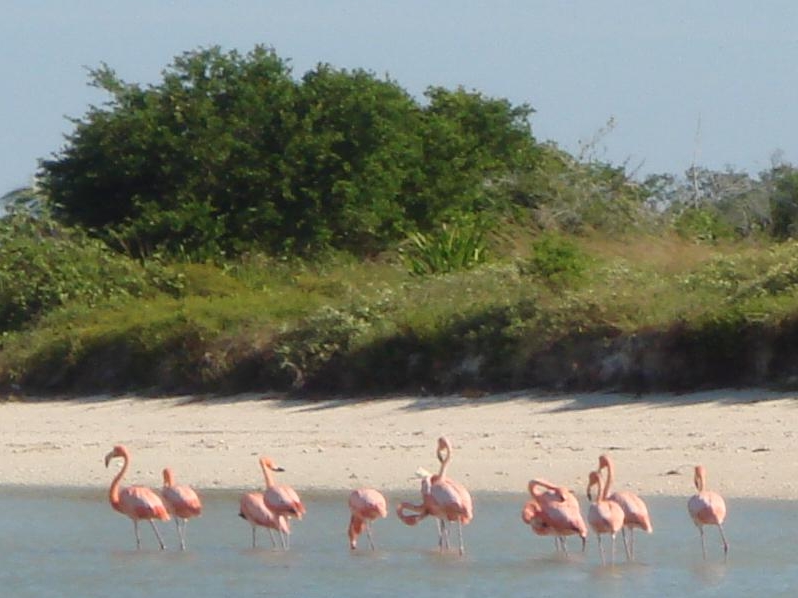Happy Thanksgiving, everyone, and to all my Indian friends, happy Diwali! This year’s Ranger Randy research assignment from the Thanksgiving gathering of family and friends involved flamingos, and the Zen question of why pink flamingos are pink. A scientist at the Monterey Bay Aquarium once told me that if you grind up a blue jay feather in a mortar and pestle, you get a neutral gray powder, and I’ve always promised myself that someday I’d do that and see if it’s true, just to keep the scientific community honest. There’s no pigment behind many of the colors you see in bird feathers. The colors, especially the vibrant colors in something like the red throat of a hummingbird, are accomplished through refraction, like the rainbowing on an oil slick. This is an extremely clever evolutionary trick, because refraction only works in direct sunlight, which means that if you’re a bird who needs to both show off and worry about predators, you can fly up into the sunlight and make a great, showy spectacle of yourself, but as soon as you drop into the shade of a bush you blink out like a light.
What’s unusual about pink flamingos is that they do have pigment in their feathers. It comes from the brine shrimp they eat. Actually, it comes from the blue-green algae that the brine shrimp eat, which contain carotenoids, an organic pigment which gives carrots and apricots their color, and also underlies a ton of biological processes including photosynthesis. The flamingos who eat more blue-green algae directly are a deeper pink than those who get the carotenoids only through the shrimp. The babies are born gray, and even an adult flamingo who does not eat the shrimp or algae will gradually turn almost completely white with only a faint pinkish blush. In zoos, they have to put pigments in their food, to keep the visitors from being extremely disappointed.
Carotenoids are also the reason that fall leaves turn the wonderful red and orange colors they do. The other pigments like chlorophyll fade first as winter approaches, leaving the carotenoids.
But here’s what really took me off on a tangent on this one. And what the hey, tangents are what I do in these articles, and that’s as it should be when you’re writing about nature. John Muir put it well: “Tug on any one thing in nature and you find it connected to everything else.” So here we go: If I understand this correctly, blue-green algae is not exactly an algae, it’s a photosynthesizing bacteria, and here’s the tangent: it’s the reason we have our atmosphere. I’m not making this up. These ancient little one-celled creatures are the reason we can breathe, and the reason our skies are blue. When their numbers in the oceans started to boom, it was 2.4 billion years ago, and there was no oxygen in our atmosphere at the time. But photosynthesis generates oxygen (which is why we will all die when we finally manage to kill all our forests), and at first the oxygen molecules they generated just combined with iron molecules in the water and sank like little molecular pebbles to the ocean floor and were never heard from again, except that they created a layer of reddish strata on the ocean floors that is still there today and provides a chronological benchmark for every geologist in the world. This went on for two hundred million years.
Then, finally, 2.4 billion years ago, the seas ran out of iron. It had all been swept up and sent to the bottom, and there was no more, and oxygen started to rise into the atmosphere.
What happened next is sometimes called the Great Oxygenation Event—and sometimes the Great Oxygen Catastrophe. To all of us, it sounds like a wonderful and blessed event, but it sort of depends on your viewpoint. Just about every anaerobic organism on Planet Earth perished as this cloud of toxic oxygen swept over the landscape killing everything in its path. It was one of the biggest extinction events in the history of our world, and it dramatically changed the trajectory of the evolution of life on this rock of ours. And the mayhem and tragedy that it caused did not end there! It also oxidized the methane in our upper atmosphere, with the result that it was no longer a greenhouse gas, and the planet was plunged into one of the most dramatic ice ages in our history, sometimes called Snowball Earth, in which some think that even the equatorial waters froze over. There’s still argument about Snowball Earth, though. Some argue that such a condition would not have had an exit door—that is, it couldn’t have happened because it couldn’t have un-happened. With that much reflectivity on the surface of the earth, our planet could never have warmed again.
But smile—we don’t have to worry about Snowball Earth. Nope, the opposite fate is staring us in the face.
And on that cheery note, I’ll leave you to enjoy your leftover Thanksgiving turkey and Diwali sweets.
Now you know.


Hi Randy, Good stuff. How much I take for granted. The Earth is a miracle. Hope all is well with you. Dave “The Woodsman” Thiele
Thanks, Dave! How are things there in Snowball Minnesota?